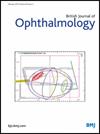Triptolide alleviates pathological neovascularisation in oxygen-induced retinopathy via inhibiting the inflammation mediated by NF-κB pathway
IF 3.5
2区 医学
Q1 OPHTHALMOLOGY
引用次数: 0
Abstract
Background Retinopathy of prematurity (ROP), an oxygen-induced retinopathy (OIR), triggers a series of vascular lesions and inflammatory responses and results in visual impairment or even blindness. Triptolide (TP) possesses many pharmacological properties, including immunosuppressive and anti-tumour effects. However, the effects of TP on ROP and its underlying mechanisms remain unclear. Purpose To investigate whether TP could inhibit the progression of OIR and to elucidate its underlying mechanisms. Methods The 7-day-old mice (P7) were kept in a 75% hyperoxia incubator for 5 days to induce an OIR model, followed by TP treatment for 5 days. Biomedical analysis and histopathological examinations of harvested retinas were conducted to explore the effect of TP. Furthermore, the impact of TP on retinal neovascularisation and microglial activation was validated using human umbilical vein endothelial cells (HUVECs) and human microglial clone 3 cells (HMC3s). Results TP treatment could significantly alleviate retinal pathological neovascularisation by inhibiting microglial activation. It downregulated the elevated levels of inflammatory cytokines (inducible nitric oxide synthase, tumour necrosis factor-α, Cox2 and interleukin (IL)-1β) and angiogenesis-related factors (hypoxia-inducible factor-1α, matrix metalloproteinase-2 and vascular endothelial growth factor-A) in OIR retinas and hypoxic HMC3s. HUVECs’ migration, proliferation and tube-forming capacities were also markedly suppressed under TP treatment. Further analysis suggested that TP exerted its anti-angiogenic effect in a way similar to NF-κB inhibitor (BAY117082). Conclusion TP alleviates pathological neovascularisation in OIR, potentially through the inhibition of inflammation mediated by NF-κB pathway. Data are available upon reasonable request. On reasonable request, the corresponding authors will provide the data that underpins the study's conclusions.雷公藤甲素通过抑制NF-κB通路介导的炎症,减轻氧诱导视网膜病变的病理性新生血管
早产儿视网膜病变(Retinopathy of prematurity, ROP)是一种氧致视网膜病变(oxygen-induced Retinopathy, OIR),可引发一系列血管病变和炎症反应,导致视力损害甚至失明。雷公藤甲素(TP)具有多种药理特性,包括免疫抑制和抗肿瘤作用。然而,TP对ROP的影响及其潜在机制尚不清楚。目的探讨TP是否能抑制OIR的发展并阐明其机制。方法将7日龄小鼠(P7)置于75%高氧培养箱中培养5 d,建立OIR模型,然后给予TP治疗5 d。通过生物医学分析和组织病理学检查,探讨TP的作用。此外,利用人脐静脉内皮细胞(HUVECs)和人小胶质克隆3细胞(HMC3s)验证了TP对视网膜新生血管和小胶质细胞活化的影响。结果TP治疗可通过抑制小胶质细胞的活化,显著缓解视网膜病理性新生血管的形成。下调OIR视网膜和缺氧HMC3s中炎性因子(诱导型一氧化氮合酶、肿瘤坏死因子-α、Cox2和白细胞介素-1β)和血管生成相关因子(缺氧诱导因子-1α、基质金属蛋白酶-2和血管内皮生长因子- a)升高的水平。TP处理也显著抑制了HUVECs的迁移、增殖和成管能力。进一步分析表明,TP发挥抗血管生成作用的方式类似于NF-κB抑制剂(BAY117082)。结论TP可能通过抑制NF-κB通路介导的炎症反应,减轻OIR病理性新生血管的形成。如有合理要求,可提供资料。应合理要求,通讯作者将提供支持研究结论的数据。
本文章由计算机程序翻译,如有差异,请以英文原文为准。
求助全文
约1分钟内获得全文
求助全文
来源期刊
CiteScore
10.30
自引率
2.40%
发文量
213
审稿时长
3-6 weeks
期刊介绍:
The British Journal of Ophthalmology (BJO) is an international peer-reviewed journal for ophthalmologists and visual science specialists. BJO publishes clinical investigations, clinical observations, and clinically relevant laboratory investigations related to ophthalmology. It also provides major reviews and also publishes manuscripts covering regional issues in a global context.

 求助内容:
求助内容: 应助结果提醒方式:
应助结果提醒方式:


